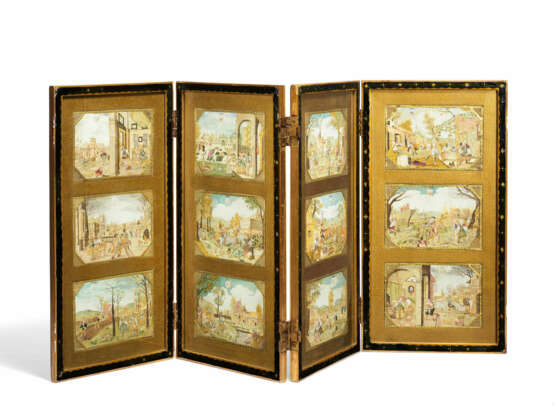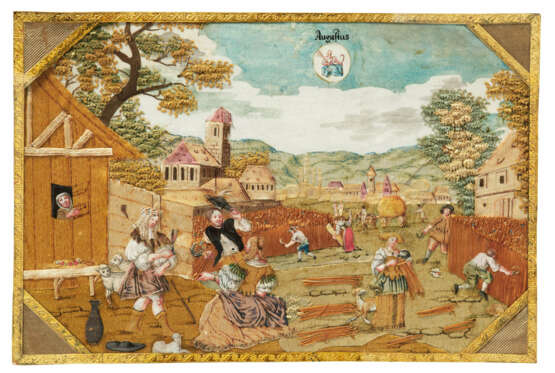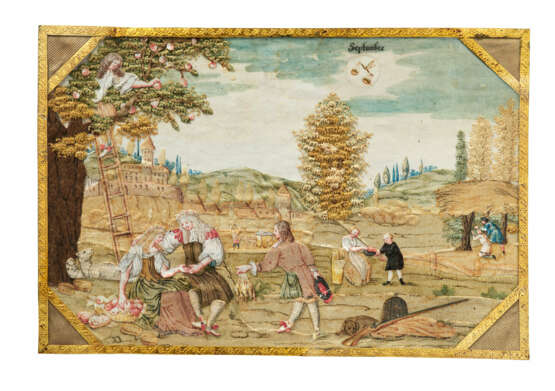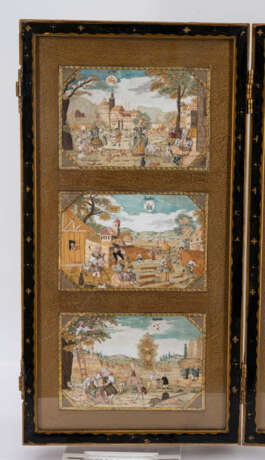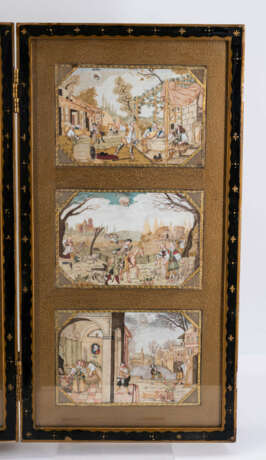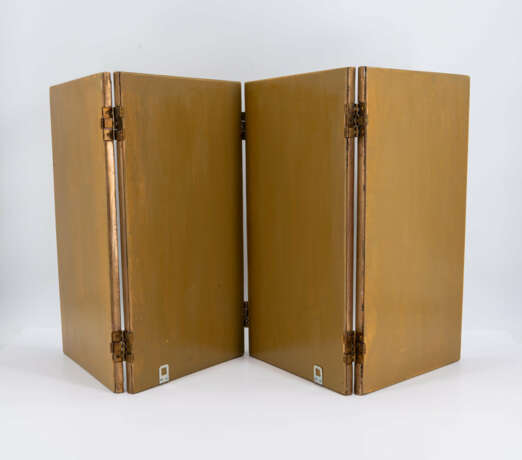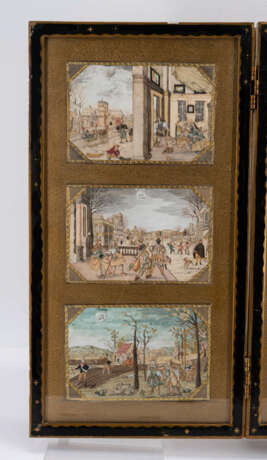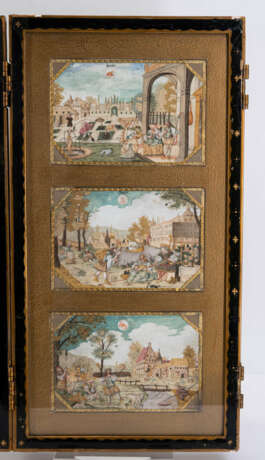ID 953409
Lot 1062 | Extraordinary cycle of the twelve months
Valeur estimée
€ 5 000 – 6 000
Germany.
Date: 2nd half 17th century.
Technique: Silk, parchment, yarn, metal wire, glass, and others.
Description: 'Januar' with sleigh and gallant interior scene, February with carnival scenes, 'Martius' with sowing peasants and gallant shepherd couple, 'Aperillis' with courtly garden and gardeners, 'Mayus' with moated castle and gallant scene in the foreground, 'Julius' with large church building in the background, Farmers in a field and gallant shepherd couple, 'Augustus' with golden ears of corn and harvesting farmers, 'September' with gallant couple under apple tree and hunter, 'October' with wine making and merry drinking scene, November with falconer on horseback and gallant shepherd couple, 'Detcember' with skaters and interior scene.
Exceptional craftsmanship. Each month is represented rich in detail and with figures characteristic for the respective month. The depictions are each made from a wide variety of silk fabric pieces, some colored and wrought with fine metal threads, as for example for the grain in the month of August. In addition, small pieces of glass for windows or water surfaces were collaged, as for example for the months of May and June. They depict courtly life in the change of the year mainly in gardens of castles or country estates. For example, the month of February shows a cheerful and figurative scene with carnivalists playing music and dancing.
Measurement: Dimensions of individual month illustrations: 12x18cm. Hinged framing: 108,5x51cm.
Framed behind glass.
Provenance:
Private collection Rhineland, purchased from Otto Buchinger Antiquitäten, Linz.
Expertise:
Prof. Dr. Kurt Rossacher, Salzburg Baroque Museum, April 21, 1982.
Literature:
Exhibit-cat.: Extra Schön - Markgräfin Sibylla Augusta und ihre Residenz - Eine Ausstellung anlässlich des 275. Todestages der Markgräfin Sibylla Augusta von Baden-Baden, Petersberg 2008. The comparative piece to the works presented here listed, described and illustrated p.130, II.10. The cycle of the twelve months is a quite exceptional Kunstkammer piece, created for close, calm contemplation of the diverse scenes and the high artistry of their execution.
In style and structure, the vignettes presented here correspond to the popular pictorial theme of seasonal and monthly depictions, as they became popular in the 17th century, especially in Flemish and Dutch visual art.
In these cycles, the change of seasons is illustrated by the altering vegetation, but also by farming activities such as working the fields or harvesting crops. In the cycle presented here, all these elements can be found within wide landscape views, with farmers in the woods or on the fields. Each of the twelve scenes, however, also shows couples or groups in courtly attire in the foreground, some of them in elaborate architectural settings. A comparative piece to the monthly cycle presented here was in the possession of Margravine Sibylla Augusta of Baden-Baden.
After the death of her husband, Margrave Ludwig Wilhelm, she became regent of the margraviate of Baden-Baden from 1707-1727. During this time, among other things, she built her porcelain castle Favorite near Rastatt. A gem not only because of the exquisite collection of early porcelains from the Meissen manufactory, but also because of the exceptionally well preserved furnishings of the chambers and representative bedrooms.
Thus, the extraordinarily lavish wall designs of the rooms, along with the still preserved furnishings, create an artistic synthesis that is unlike any other. The margravine commissioned the finest damask fabrics to be combined with a wide variety of embroidery techniques. Thus, using silver wire or glass beadwork, they serve as sometimes elaborate frames for mythological and allegorical scenes or form independent, three-dimensional floral and ornamental decorations.
The small Kunstkammer piece from Sibylla Augusta's posession, which we can consult for comparison, shows a pastoral landscape that creates the detailed backdrop for a biblical scene using the same technique and a wide variety of materials such as silk and silk yarn. It was probably an heirloom and not part of any of the lavish room arrangements at Favorit Palace. Instead it was treasured by the art-minded margravine, as it is described in her estate inventory in as much detail as other, very precious objects. A clear sign of the rarity and special nature of this work, as it is also demonstrated to us in the wonderful cycle of the twelve months.
| Catégorie maison de vente aux enchères: | Premières œuvres d'art |
|---|
| Catégorie maison de vente aux enchères: | Premières œuvres d'art |
|---|
| Adresse de l'enchère |
VAN HAM Kunstauktionen GmbH Hitzelerstr. 2 50968 Köln Allemagne | ||||||||||||||
|---|---|---|---|---|---|---|---|---|---|---|---|---|---|---|---|
| Aperçu |
| ||||||||||||||
| Téléphone | +49 221 92586215 | ||||||||||||||
| Fax | +49 221 92 58 62 4 | ||||||||||||||
| Commission | 32% | ||||||||||||||
| Conditions d'utilisation | Conditions d'utilisation | ||||||||||||||
| Heures d'ouverture | Heures d'ouverture
|
